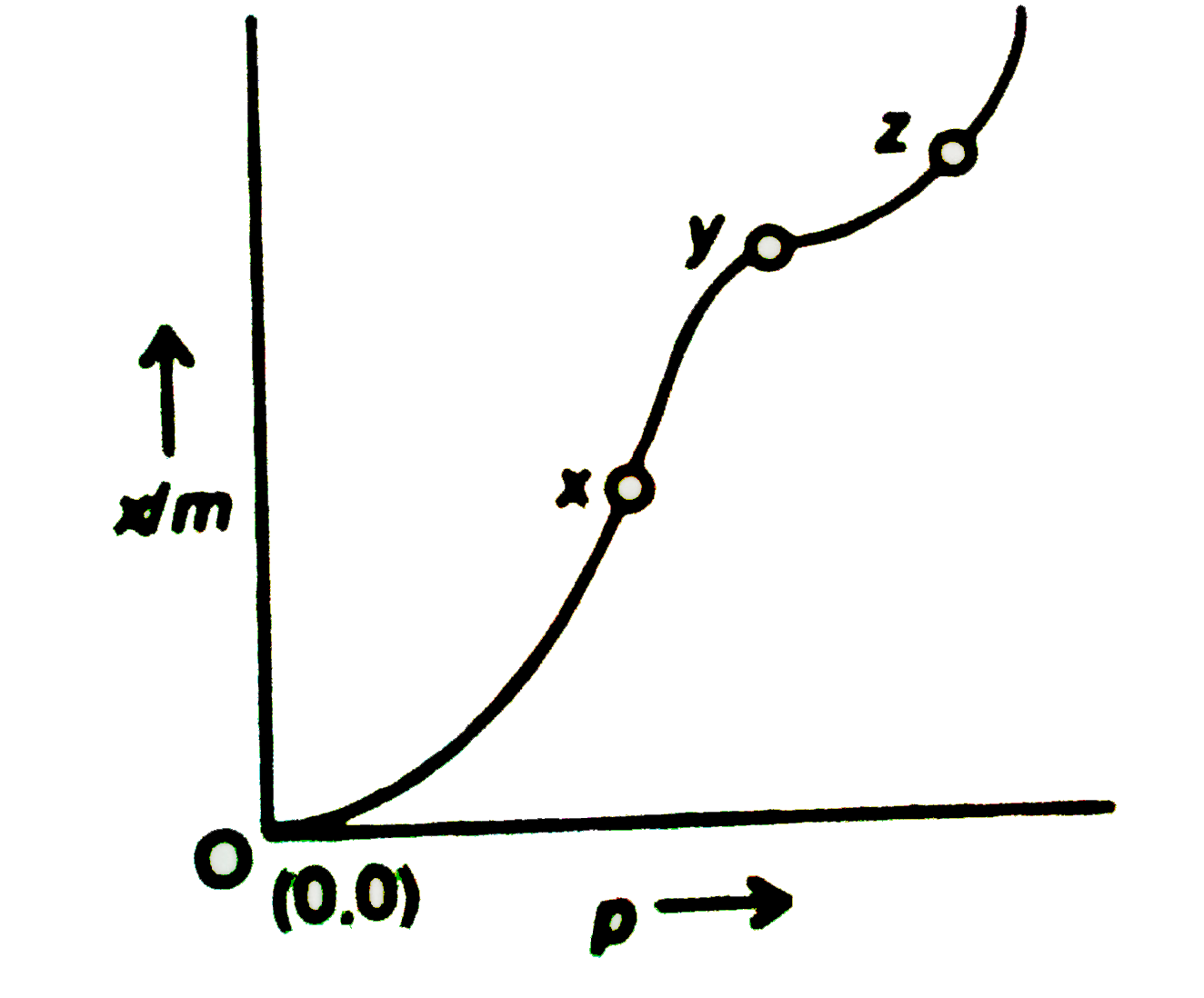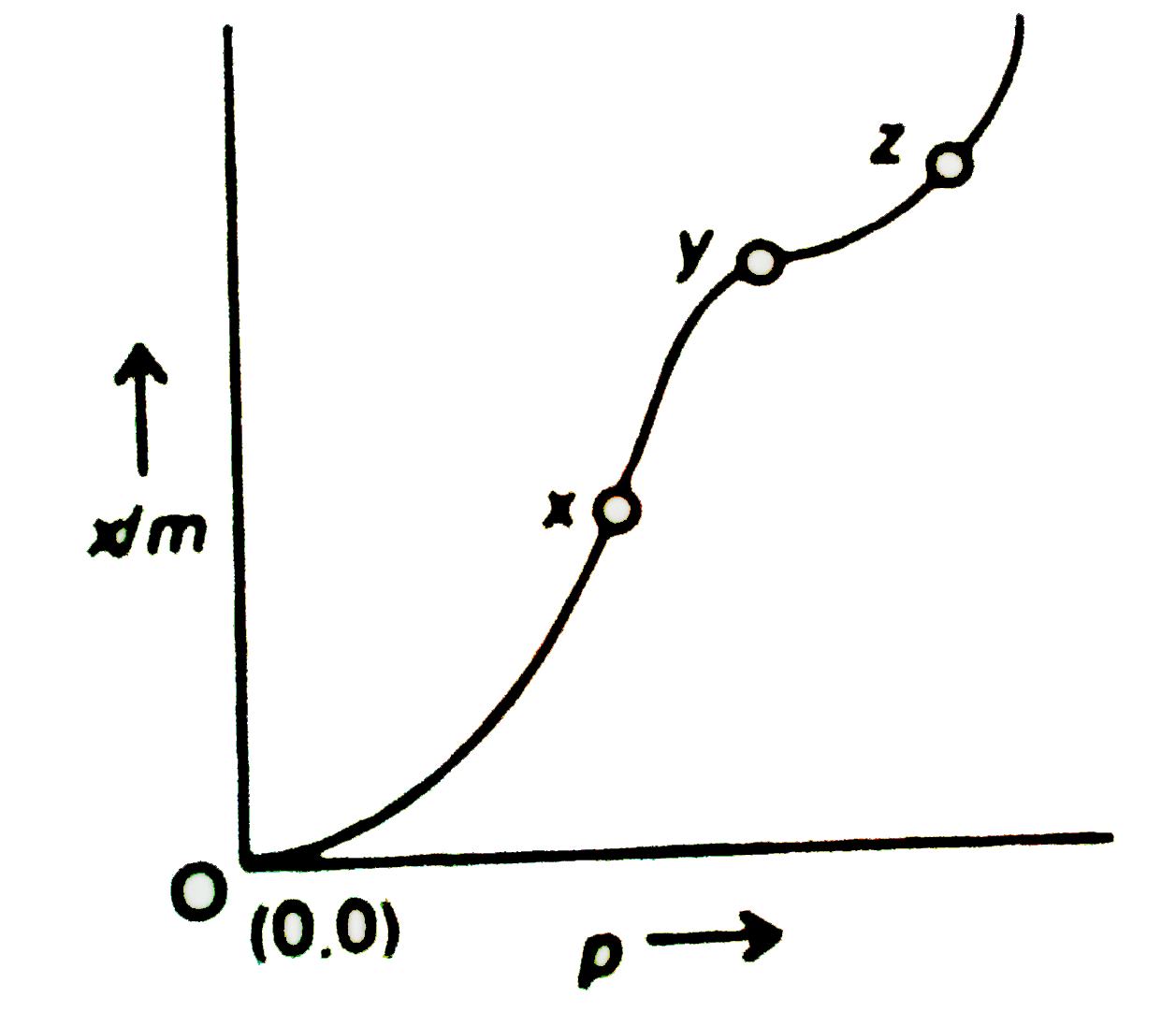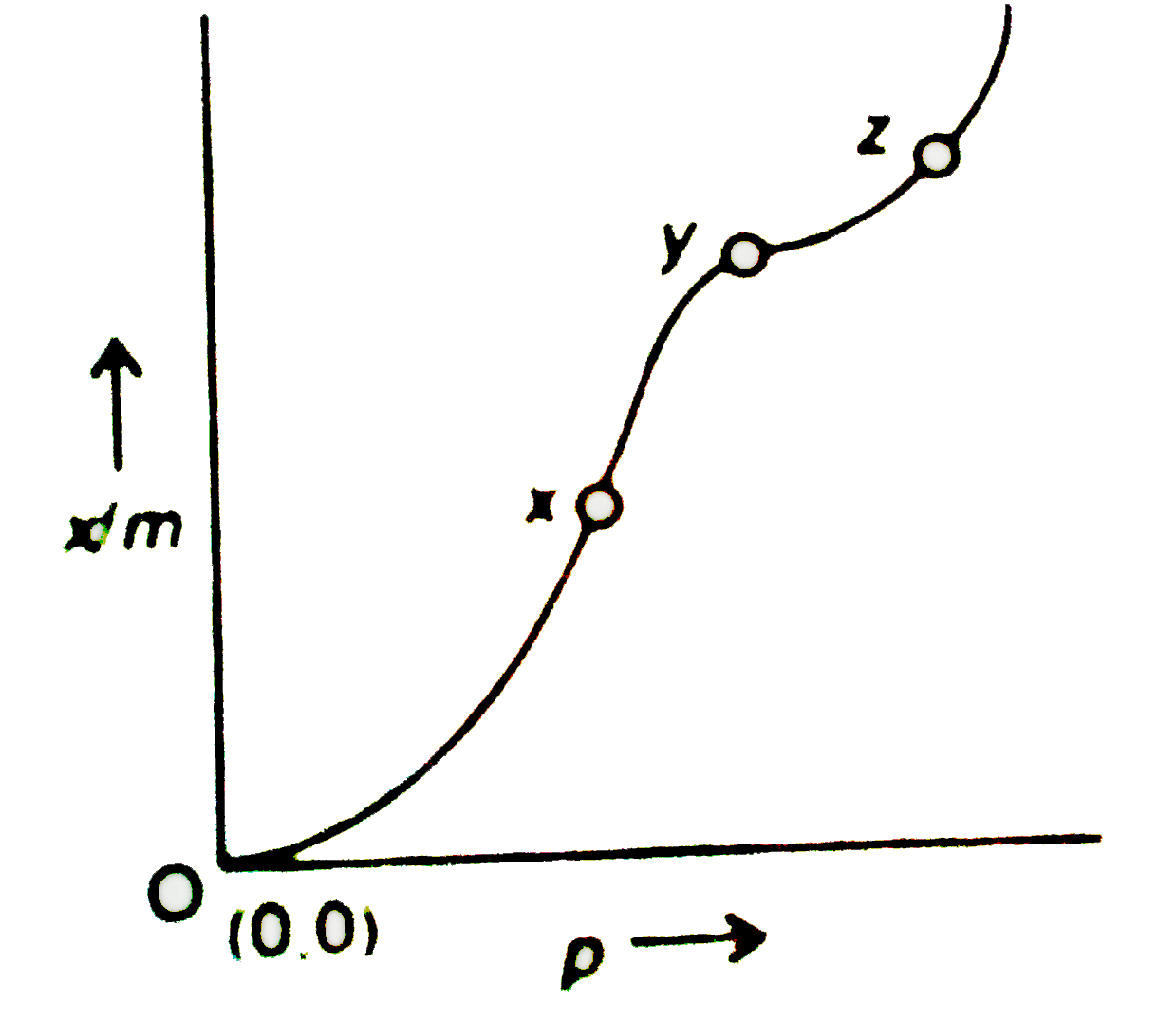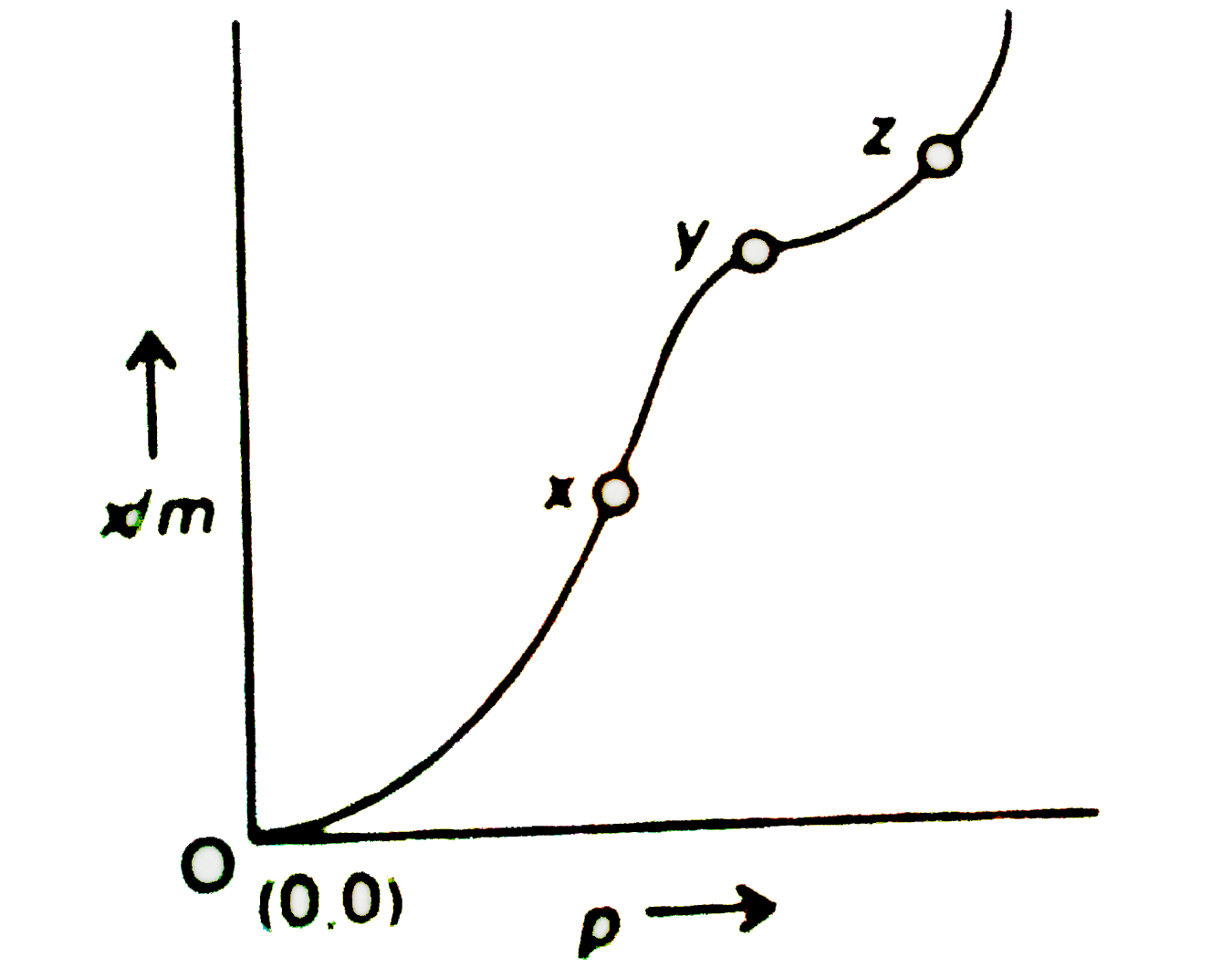Complete Solutions to Linked Comprehension Type MCQs of chapter SURFACE CHEMISTRY of Class 11 book with complete answers and questions
| Class 11 | CHEMISTRY |
| Chapter | SURFACE CHEMISTRY |
| DINESH OBJECTIVE CHEMISTRY | Linked Comprehension Type MCQs |
| Number Of Questions | 10 |
| Academic Year | 2023-24 |
The amount of gas adsorbed (x/m) is the function of temperature and pressure, which can be shown as under
`(x)/(m)`= f(p,T)
The variation x/m and p, at constant temperature is known as adsorption isotherm
i.e., x/m=f(p) at constant temperature
Seven type of physisorption isotherms are known. Some of them are shown below

Physisorption Type I. Where there is formation of monolayer on the surface of adsorbent, this type of curve is obtained.
Physisorption Type II. The transition point 'X' of this physisorption isotherm indicates, that the formation of mono layer is complete and that of multilayer is started.
Physisorption Type III. This isotherm has no transition point. In this type of curve, the multimolecular starts before the completion of monomolecular layer.
On the basis of this comprehension, answer teh following question from the physisorption isotherm of a gas on a solid shown as under.

The portion ''OX'' of the physisorption isotherm representsView SolutionThe amount of gas adsorbed (x/m) is the function of temperature and pressure, which can be shown as under
`(x)/(m)`= f(p,T)
The variation x/m and p, at constant temperature is known as adsorption isotherm
i.e., x/m=f(p) at constant temperature
Seven type of physisorption isotherms are known. Some of them are shown below

Physisorption Type I. Where there is formation of monolayer on the surface of adsorbent, this type of curve is obtained.
Physisorption Type II. The transition point 'X' of this physisorption isotherm indicates, that the formation of mono layer is complete and that of multilayer is started.
Physisorption Type III. This isotherm has no transition point. In this type of curve, the multimolecular starts before the completion of monomolecular layer.
On the basis of this comprehension, answer teh following question from the physisorption isotherm of a gas on a solid shown as under.

The portion XY of the curve correctly representsView SolutionThe amount of gas adsorbed (x/m) is the function of temperature and pressure, which can be shown as under
`(x)/(m)`= f(p,T)
The variation x/m and p, at constant temperature is known as adsorption isotherm
i.e., x/m=f(p) at constant temperature
Seven type of physisorption isotherms are known. Some of them are shown below

Physisorption Type I. Where there is formation of monolayer on the surface of adsorbent, this type of curve is obtained.
Physisorption Type II. The transition point 'X' of this physisorption isotherm indicates, that the formation of mono layer is complete and that of multilayer is started.
Physisorption Type III. This isotherm has no transition point. In this type of curve, the multimolecular starts before the completion of monomolecular layer.
On the basis of this comprehension, answer teh following question from the physisorption isotherm of a gas on a solid shown as under.

The point Y of physisorption isotherm correctly representsView SolutionThe amount of gas adsorbed (x/m) is the function of temperature and pressure, which can be shown as under
`(x)/(m)`= f(p,T)
The variation x/m and p, at constant temperature is known as adsorption isotherm
i.e., x/m=f(p) at constant temperature
Seven type of physisorption isotherms are known. Some of them are shown below

Physisorption Type I. Where there is formation of monolayer on the surface of adsorbent, this type of curve is obtained.
Physisorption Type II. The transition point 'X' of this physisorption isotherm indicates, that the formation of mono layer is complete and that of multilayer is started.
Physisorption Type III. This isotherm has no transition point. In this type of curve, the multimolecular starts before the completion of monomolecular layer.
On the basis of this comprehension, answer teh following question from the physisorption isotherm of a gas on a solid shown as under.

The point Z of the physisorption correctly representsView SolutionIn the macromolecular type of colloids, the dispersed particles are themselves large molecules (usually polymer). Since these molecules have dimesions comparable to those of colloidal particles, their dispersions are called macromolecular colloids. Most lyophilic sols belong to this category.
There are certain colloids which behave as normal strong electrolytes at low concentrations, but exhibit colloidal properties at higher concentrations due to the formation of aggergated particles. These are known as micelles associated colloids. Surface active agents like soaps and synthetic detergents belong to this class.
Critical micelle concentration ( C.M.C) is the lowest concentration at which micelle formation appears. C.M.C. increase with the total surfactant concentration. At the concentration higher than C.M.C. they form extended parallel sheets known as lamellar micelles which resemble biological membranes which are two molecules thick. The individual molecule is perpendicular to the sheets such that hydrophilic groups are on the outside in aqueous solution and hydrophobic on the inside in a nonpolar medium.
In concentrated solution, micelles take the form of long cylinders packed in hexagonal arrays and are called hytotropic mesomorphs .
in an aqueous solution (polar medium), the polar groups point toward the periphery and the hydrophobic hydrocarbon chains point toward the canter forming the core of the micelle.
Micelles from the ionic surfactants can be formed only above a certain temperature called the kraft temperature they are capable of forming ions molecules of soaps and detergents consist of lyophilic as well as lyophobic parts which associate together to form micelles. Micelles may contain as many as 100 molecules or more.
Select the incorrect statement (s)View SolutionIn the macromolecular type of colloids, the dispersed particles are themselves large molecules (usually polymer). Since these molecules have dimesions comparable to those of colloidal particles, their dispersions are called macromolecular colloids. Most lyophilic sols belong to this category.
There are certain colloids which behave as normal strong electrolytes at low concentrations, but exhibit colloidal properties at higher concentrations due to the formation of aggergated particles. These are known as micelles associated colloids. Surface active agents like soaps and synthetic detergents belong to this class.
Critical micelle concentration ( C.M.C) is the lowest concentration at which micelle formation appears. C.M.C. increase with the total surfactant concentration. At the concentration higher than C.M.C. they form extended parallel sheets known as lamellar micelles which resemble biological membranes which are two molecules thick. The individual molecule is perpendicular to the sheets such that hydrophilic groups are on the outside in aqueous solution and hydrophobic on the inside in a nonpolar medium.
In concentrated solution, micelles take the form of long cylinders packed in hexagonal arrays and are called hytotropic mesomorphs .
in an aqueous solution (polar medium), the polar groups point toward the periphery and the hydrophobic hydrocarbon chains point toward the canter forming the core of the micelle.
Micelles from the ionic surfactants can be formed only above a certain temperature called the kraft temperature they are capable of forming ions molecules of soaps and detergents consist of lyophilic as well as lyophobic parts which associate together to form micelles. Micelles may contain as many as 100 molecules or more.
Which part of soap `(RCOO^(-))` dissolves grease and forms micelle ?View SolutionIn the macromolecular type of colloids, the dispersed particles are themselves large molecules (usually polymer). Since these molecules have dimesions comparable to those of colloidal particles, their dispersions are called macromolecular colloids. Most lyophilic sols belong to this category.
There are certain colloids which behave as normal strong electrolytes at low concentrations, but exhibit colloidal properties at higher concentrations due to the formation of aggergated particles. These are known as micelles associated colloids. Surface active agents like soaps and synthetic detergents belong to this class.
Critical micelle concentration ( C.M.C) is the lowest concentration at which micelle formation appears. C.M.C. increase with the total surfactant concentration. At the concentration higher than C.M.C. they form extended parallel sheets known as lamellar micelles which resemble biological membranes which are two molecules thick. The individual molecule is perpendicular to the sheets such that hydrophilic groups are on the outside in aqueous solution and hydrophobic on the inside in a nonpolar medium.
In concentrated solution, micelles take the form of long cylinders packed in hexagonal arrays and are called hytotropic mesomorphs .
in an aqueous solution (polar medium), the polar groups point toward the periphery and the hydrophobic hydrocarbon chains point toward the canter forming the core of the micelle.
Micelles from the ionic surfactants can be formed only above a certain temperature called the kraft temperature they are capable of forming ions molecules of soaps and detergents consist of lyophilic as well as lyophobic parts which associate together to form micelles. Micelles may contain as many as 100 molecules or more.
In multimolecular colloidal sols, atoms or molecules are held together byView SolutionIn the macromolecular type of colloids, the dispersed particles are themselves large molecules (usually polymer). Since these molecules have dimesions comparable to those of colloidal particles, their dispersions are called macromolecular colloids. Most lyophilic sols belong to this category.
There are certain colloids which behave as normal strong electrolytes at low concentrations, but exhibit colloidal properties at higher concentrations due to the formation of aggergated particles. These are known as micelles associated colloids. Surface active agents like soaps and synthetic detergents belong to this class.
Critical micelle concentration ( C.M.C) is the lowest concentration at which micelle formation appears. C.M.C. increase with the total surfactant concentration. At the concentration higher than C.M.C. they form extended parallel sheets known as lamellar micelles which resemble biological membranes which are two molecules thick. The individual molecule is perpendicular to the sheets such that hydrophilic groups are on the outside in aqueous solution and hydrophobic on the inside in a nonpolar medium.
In concentrated solution, micelles take the form of long cylinders packed in hexagonal arrays and are called hytotropic mesomorphs .
in an aqueous solution (polar medium), the polar groups point toward the periphery and the hydrophobic hydrocarbon chains point toward the canter forming the core of the micelle.
Micelles from the ionic surfactants can be formed only above a certain temperature called the kraft temperature they are capable of forming ions molecules of soaps and detergents consist of lyophilic as well as lyophobic parts which associate together to form micelles. Micelles may contain as many as 100 molecules or more.
Select the correct statement about phopholipidsView SolutionIn the macromolecular type of colloids, the dispersed particles are themselves large molecules (usually polymer). Since these molecules have dimesions comparable to those of colloidal particles, their dispersions are called macromolecular colloids. Most lyophilic sols belong to this category.
There are certain colloids which behave as normal strong electrolytes at low concentrations, but exhibit colloidal properties at higher concentrations due to the formation of aggergated particles. These are known as micelles associated colloids. Surface active agents like soaps and synthetic detergents belong to this class.
Critical micelle concentration ( C.M.C) is the lowest concentration at which micelle formation appears. C.M.C. increase with the total surfactant concentration. At the concentration higher than C.M.C. they form extended parallel sheets known as lamellar micelles which resemble biological membranes which are two molecules thick. The individual molecule is perpendicular to the sheets such that hydrophilic groups are on the outside in aqueous solution and hydrophobic on the inside in a nonpolar medium.
In concentrated solution, micelles take the form of long cylinders packed in hexagonal arrays and are called hytotropic mesomorphs .
in an aqueous solution (polar medium), the polar groups point toward the periphery and the hydrophobic hydrocarbon chains point toward the canter forming the core of the micelle.
Micelles from the ionic surfactants can be formed only above a certain temperature called the kraft temperature they are capable of forming ions molecules of soaps and detergents consist of lyophilic as well as lyophobic parts which associate together to form micelles. Micelles may contain as many as 100 molecules or more.
Cleansing action of soap occurs becauseView SolutionIn the macromolecular type of colloids, the dispersed particles are themselves large molecules (usually polymer). Since these molecules have dimesions comparable to those of colloidal particles, their dispersions are called macromolecular colloids. Most lyophilic sols belong to this category.
There are certain colloids which behave as normal strong electrolytes at low concentrations, but exhibit colloidal properties at higher concentrations due to the formation of aggergated particles. These are known as micelles associated colloids. Surface active agents like soaps and synthetic detergents belong to this class.
Critical micelle concentration ( C.M.C) is the lowest concentration at which micelle formation appears. C.M.C. increase with the total surfactant concentration. At the concentration higher than C.M.C. they form extended parallel sheets known as lamellar micelles which resemble biological membranes which are two molecules thick. The individual molecule is perpendicular to the sheets such that hydrophilic groups are on the outside in aqueous solution and hydrophobic on the inside in a nonpolar medium.
In concentrated solution, micelles take the form of long cylinders packed in hexagonal arrays and are called hytotropic mesomorphs .
in an aqueous solution (polar medium), the polar groups point toward the periphery and the hydrophobic hydrocarbon chains point toward the canter forming the core of the micelle.
Micelles from the ionic surfactants can be formed only above a certain temperature called the kraft temperature they are capable of forming ions molecules of soaps and detergents consist of lyophilic as well as lyophobic parts which associate together to form micelles. Micelles may contain as many as 100 molecules or more.
2.56 g of sulphur (colloidal sulphur) in 100mL solution shows osmotic pressure of 2.463 atm at `27^(@)C`. How many sulphur atoms are associated in a colloidal sol ?
(Solution constant =0.0821 L atm `mol^(-1) K^(-1)`)View Solution
Linked Comprehension Type MCQs questions and complete solutions for chapter SURFACE CHEMISTRY of S DINESH & CO CHEMISTRY (HINGLISH) of Class 11
